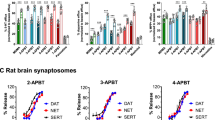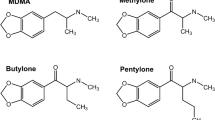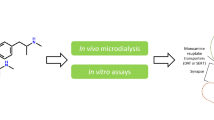Abstract
Rationale
The nonmedical use of new psychoactive substances (NPS) is a worldwide public health concern. The so-called “benzofury” compounds, 5-(2-aminopropyl)benzofuran (5-APB) and 6-(2-aminopropyl)benzofuran (6-APB), are NPS with stimulant-like properties in human users. These substances are known to interact with monoamine transporters and 5-HT receptors in transfected cells, but less is known about their effects in animal models.
Methods
Here, we used in vitro monoamine transporter assays in rat brain synaptosomes to characterize the effects of 5-APB and 6-APB, together with their N-methyl derivatives 5-MAPB and 6-MAPB, in comparison with 3,4-methylenedioxyamphetamine (MDA) and 3,4-methylenedioxymethamphetamine (MDMA). In vivo neurochemical and behavioral effects of 5-APB (0.3 and 1.0 mg/kg, i.v.) and 6-APB (0.3 and 1.0 mg/kg, i.v.) were assessed in comparison with MDA (1.0 and 3.0 mg/kg, i.v.) using microdialysis sampling in the nucleus accumbens of conscious male rats.
Results
All four benzofuran derivatives were substrate-type releasers at dopamine transporters (DAT), norepinephrine transporters (NET), and serotonin transporters (SERT) with nanomolar potencies, similar to the profile of effects produced by MDA and MDMA. However, the benzofurans were at least threefold more potent than MDA and MDMA at evoking transporter-mediated release. Like MDA, both benzofurans induced dose-related elevations in extracellular dopamine and serotonin in the brain, but benzofurans were more potent than MDA. The benzofuran derivatives also induced profound behavioral activation characterized by forward locomotion which lasted for at least 2 h post-injection.
Conclusions
Overall, benzofurans are more potent than MDA in vitro and in vivo, producing sustained stimulant-like effects in rats. These data suggest that benzofuran-type compounds may have abuse liability and could pose risks for adverse effects, especially if used in conjunction with abused drugs or medications which enhance monoamine transmission in the brain.






Similar content being viewed by others
References
Adamowicz P, Zuba D, Byrska B (2014) Fatal intoxication with 3-methyl-N-methylcathinone (3-MMC) and 5-(2-aminopropyl)benzofuran (5-APB). Forensic Sci Int 245:126–132. https://doi.org/10.1016/j.forsciint.2014.10.016
Baumann MH, Ayestas MA Jr, Partilla JS, Sink JR, Shulgin AT, Daley PF, Brandt SD, Rothman RB, Ruoho AE, Cozzi NV (2012) The designer methcathinone analogs, mephedrone and methylone, are substrates for monoamine transporters in brain tissue. Neuropsychopharmacology 37:1192–1203. https://doi.org/10.1038/npp.2011.304
Baumann MH, Clark RD, Woolverton WL, Wee SM, Blough BE, Rothman RB (2011) In vivo effects of amphetamine analogs reveal evidence for serotonergic inhibition of mesolimbic dopamine transmission in the rat. J Pharmacol Exp Ther 337:218–225. https://doi.org/10.1124/jpet.110.176271
Baumann MH, Partilla JS, Lehner KR, Thorndike EB, Hoffman AF, Holy M, Rothman RB, Goldberg SR, Lupica CR, Sitte HH, Brandt SD, Srihari RT, Cozzi NV, Schindler CW (2013) Powerful cocaine-like actions of 3,4-methylenedioxypyrovalerone (MDPV), a principal constituent of psychoactive “bath salts” products. Neuropsychopharmacology 38:552–562. https://doi.org/10.1038/npp.2012.204
Baumann MH, Volkow ND (2016) Abuse of new psychoactive substances: threats and solutions. Neuropsychopharmacology 41:663–665. https://doi.org/10.1038/npp.2015.260
Baumann MH, Wang XY, Rothman RB (2007) 3,4-Methylenedioxymethamphetamine (MDMA) neurotoxicity in rats: a reappraisal of past and present findings. Psychopharmacology 189:407–424. https://doi.org/10.1007/s00213-006-0322-6
Bonci A, Bernardi G, Grillner P, Mercuri NB (2003) The dopamine-containing neuron: maestro or simple musician in the orchestra of addiction? Trends Pharmacol Sci 24:172–177. https://doi.org/10.1016/S0165-6147(03)00068-3
Brandt SD, Baumann MH, Partilla JS, Kavanagh PV, Power JD, Talbot B, Twamley B, O’Brien J, Mahony O, Elliott SP, Archer RP, Patrick J, Singh K, Dempster NM, Cosbey SH (2014a) Characterization of a novel and potentially lethal designer drug, (±)-cis-para-methyl-4-methylaminorex (4,4′-DMAR, or 'Serotoni'). Drug Test Anal 6:684–695. https://doi.org/10.1002/dta.1668
Brandt SD, King LA, Evans-Brown M (2014b) The new drug phenomenon. Drug Test Anal 6:587–597. https://doi.org/10.1002/dta.1686
Briner K, Burkhart JP, Burkholder TP, Fisher MJ, Gritton WH, Kohlman DT, Liang SX, Miller SC, Mullaney JT, Xu Y-C, Xu Y (2000) Aminoalkylbenzofurans as serotonin (5-HT(2C)) agonists. Patent no. WO2000044737A1, Eli Lilly and Company, Indianapolis, IN, USA, 2000
Briner K, Burkhart JP, Burkholder TP, Fisher MJ, Gritton WH, Kohlman DT, Liang SX, Miller SC, Mullaney JT, Xu YC (2006) Aminoalkylbenzofurans as serotonin (5-HT(2C)) agonists. Patent no. US7045545B1, Eli Lilly and Company, Indianapolis, IN, USA, 2006
Brunt TM, Nagy C, Bücheli A, Martins D, Ugarte M, Beduwe C, Ventura Vilamala M (2017) Drug testing in Europe: monitoring results of the Trans European Drug Information (TEDI) project. Drug Test Anal 9:188–198. https://doi.org/10.1002/dta.1954
Casale JF, Hays PA (2012) The characterization of 6-(2-aminopropyl)benzofuran and differentiation from its 4-, 5-, and 7-positional analogues. Microgram J 9:61–74
Cha HJ, Lee KW, Eom JH, Kim YH, Shin J, Yun J, Han K, Kim HS (2016) 5-(2-Aminopropyl)benzofuran and phenazepam demonstrate the possibility of dependence by increasing dopamine levels in the brain. Pharmacol Biochem Behav 149:17–22. https://doi.org/10.1016/j.pbb.2016.08.002
Chan WL, Wood DM, Hudson S, Dargan PI (2013) Acute psychosis associated with recreational use of benzofuran 6-(2-aminopropyl)benzofuran (6-APB) and cannabis. J Med Toxicol 9:278–281. https://doi.org/10.1007/s13181-013-0306-y
Daveluy A, Géniaux H, Eiden C, Boucher A, Chenaf C, Deheul S, Spadari M, Gérardin M, Miremont-Salamé G, Haramburu F, French Network of Addictovigilance Centres (2016) Illicit drugs or medicines taken by parachuting. Fundam Clin Pharmacol 30:185–190. https://doi.org/10.1111/fcp.12172
Dawson P, Opacka-Juffry J, Moffatt JD, Daniju Y, Dutta N, Ramsey J, Davidson C (2014) The effects of benzofury (5-APB) on the dopamine transporter and 5-HT2-dependent vasoconstriction in the rat. Prog Neuro-Psychopharmacol Biol Psychiatry 48:57–63. https://doi.org/10.1016/j.pnpbp.2013.08.013
Dolan SB, Forster MJ, Gatch MB (2017) Discriminative stimulus and locomotor effects of para-substituted and benzofuran analogs of amphetamine. Drug Alcohol Depend 180:39–45. https://doi.org/10.1016/j.drugalcdep.2017.07.041
Elliott S, Evans J (2014) A 3-year review of new psychoactive substances in casework. Forensic Sci Int 243:55–60. https://doi.org/10.1016/j.forsciint.2014.04.017
EMCDDA-Europol (2011) EMCDDA-Europol 2010 Annual Report on the implementation of Council Decision 2005/387/JHA. Lisbon, Portugal. Available at: http://www.emcdda.europa.eu/system/files/publications/644/EMCDDA-Europol_Annual_Report_2010A_281336.pdf [15 May 2016]
EMCDDA-Europol (2012) EMCDDA-Europol 2011 Annual Report on the implementation of Council Decision 2005/387/JHA. Lisbon, Portugal. Available at: http://www.emcdda.europa.eu/system/files/publications/689/EMCDDA-Europol_Annual_Report_2011_2012_final_335568.pdf [15 May 2016]
EMCDDA-Europol (2014) EMCDDA-Europol 2013 Annual Report on the implementation of Council Decision 2005/387/JHA. Lisbon, Portugal. Available at: http://www.emcdda.europa.eu/system/files/publications/814/TDAN14001ENN_475519.pdf [15 May 2016]
Eshleman AJ, Nagarajan S, Wolfrum KM, Reed JF, Swanson TL, Nilsen A, Janowsky A (2019) Structure-activity relationships of bath salt components: substituted cathinones and benzofurans at biogenic amine transporters. Psychopharmacology 236:939–952. https://doi.org/10.1007/s00213-018-5059-5
Evans-Brown M, Sedefov R (2018) Responding to new psychoactive substances in the European Union: early warning, risk assessment, and control measures. Handb Exp Pharmacol 252:3–49. https://doi.org/10.1007/164_2018_160
Fuwa T, Suzuki J, Tanaka T, Inomata A, Honda Y, Kodama T (2016) Novel psychoactive benzofurans strongly increase extracellular serotonin level in mouse corpus striatum. J Toxicol Sci 41:329–337. https://doi.org/10.2131/jts.41.329
Gatch MB, Dolan SB, Forster MJ (2019) Locomotor activity and discriminative stimulus effects of five novel synthetic cathinone analogs in mice and rats. Drug Alcohol Depend 199:50–58. https://doi.org/10.1016/j.drugalcdep.2019.02.016
Glennon RA (2014) Bath salts, mephedrone, and methylenedioxypyrovalerone as emerging illicit drugs that will need targeted therapeutic intervention. In: Linda PD (ed) Advances in Pharmacology. Academic Press, pp 581-620
Greene SL (2013) Benzofurans and benzodifurans. In: Dargan PI, Wood DM (eds) Novel psychoactive substances classification. Pharmacology and Toxicology. Academic Press, London, pp 383–392
Hofer KE, Faber K, Muller DM, Hauffe T, Wenger U, Kupferschmidt H, Rauber-Luthy C (2017) Acute toxicity associated with the recreational use of the novel psychoactive benzofuran N-methyl-5-(2 aminopropyl)benzofuran. Ann Emerg Med 69:79–82. https://doi.org/10.1016/j.annemergmed.2016.03.042
Hondebrink L, Zwartsen A, Westerink RHS (2018) Effect fingerprinting of new psychoactive substances (NPS): what can we learn from in vitro data? Pharmacol Ther 182:193–224. https://doi.org/10.1016/j.pharmthera.2017.10.022
Iversen L, Gibbons S, Treble R, Setola V, Huang X-P, Roth BL (2013) Neurochemical profiles of some novel psychoactive substances. Eur J Pharmacol 700:147–151. https://doi.org/10.1016/j.ejphar.2012.12.006
Kamour A, James D, Lupton DJ, Cooper G, Eddleston M, Vale A, Thompson JP, Thanacoody R, Hill SL, Thomas SH (2014) Patterns of presentation and clinical features of toxicity after reported use of ([2-aminopropyl]-2,3-dihydrobenzofurans), the 'benzofuran' compounds. A report from the United Kingdom National Poisons Information Service. Clin Toxicol 52:1025–1031. https://doi.org/10.3109/15563650.2014.973115
Kim M, Yang CH, Lee YS, Jang C-G, Oh S, Lee S (2019) Effects of aromatic ring-substituted phenethylamines on the release of dopamine and serotonin. Forensic Toxicol 37:104–112. https://doi.org/10.1007/s11419-018-0440-y
King LA (2014) New phenethylamines in Europe. Drug Test Anal 6:808–818. https://doi.org/10.1002/dta.1570
Kolanos R, Saldoth F, Jain AD, Partilla JS, Baumann MH, Glennon RA (2015) Structural modification of the designer stimulant α-pyrrolidinovalerophenone (α-PVP) influences potency at dopamine transporters. ACS Chem Neurosci 6:1726–1731. https://doi.org/10.1021/acschemneuro.5b00160
Krpo M, Luytkis HC, Haneborg AM, Hoiseth G (2018) A fatal blood concentration of 5-APB. Forensic Sci Int 291:e1–e3. https://doi.org/10.1016/j.forsciint.2018.08.044
Luethi D, Kolaczynska KE, Docci L, Krahenbuhl S, Hoener MC, Liechti ME (2018) Pharmacological profile of mephedrone analogs and related new psychoactive substances. Neuropharmacology 134:4–12. https://doi.org/10.1016/j.neuropharm.2017.07.026
Luethi D, Kolaczynska KE, Walter M, Suzuki M, Rice KC, Blough BE, Hoener MC, Baumann MH, Liechti ME (2019) Metabolites of the ring-substituted stimulants MDMA, methylone and MDPV differentially affect human monoaminergic systems. J Psychopharmacol 33:831–841. https://doi.org/10.1177/0269881119844185
Luethi D, Liechti ME (2020) Designer drugs: mechanism of action and adverse effects. Arch Toxicol 94:1085–1133. https://doi.org/10.1007/s00204-020-02693-7
Madras BK (2017) The growing problem of new psychoactive substances (NPS). Curr Top Behav Neurosci 32:1–18. https://doi.org/10.1007/7854_2016_34
Maier J, Mayer FP, Luethi D, Holy M, Jäntsch K, Reither H, Hirtler L, Hoener MC, Liechti ME, Pifl C, Brandt SD, Sitte HH (2018) The psychostimulant (±)-cis-4,4′-dimethylaminorex (4,4′-DMAR) interacts with human plasmalemmal and vesicular monoamine transporters. Neuropharmacology 138:282–291. https://doi.org/10.1016/j.neuropharm.2018.06.018
Marusich JA, Antonazzo KR, Blough BE, Brandt SD, Kavanagh PV, Partilla JS, Baumann MH (2016) The new psychoactive substances 5-(2-aminopropyl)indole (5-IT) and 6-(2-aminopropyl)indole (6-IT) interact with monoamine transporters in brain tissue. Neuropharmacology 101:68–75. https://doi.org/10.1016/j.neuropharm.2015.09.004
McIntyre IM, Gary RD, Trochta A, Stolberg S, Stabley R (2015) Acute 5-(2-aminopropyl)benzofuran (5-APB) intoxication and fatality: a case report with postmortem concentrations. J Anal Toxicol 39:156–159. https://doi.org/10.1093/jat/bku131
McLaughlin G, Morris N, Kavanagh PV, Power JD, Twamley B, O'Brien J, Talbot B, Dowling G, Mahony O, Brandt SD, Patrick J, Archer RP, Partilla JS, Baumann MH (2015) Synthesis, characterization, and monoamine transporter activity of the new psychoactive substance 3′,4′-methylenedioxy-4-methylaminorex (MDMAR). Drug Test Anal 7:555–564. https://doi.org/10.1002/dta.1732
Nakagawa Y, Suzuki T, Inomata A (2018) Preventive effects of fructose and N-acetyl-L-cysteine against cytotoxicity induced by the psychoactive compounds N-methyl-5-(2-aminopropyl)benzofuran and 3,4-methylenedioxy-N-methamphetamine in isolated rat hepatocytes. J Appl Toxicol 38:284–291. https://doi.org/10.1002/jat.3523
Nakagawa Y, Suzuki T, Tada Y, Inomata A (2017) Cytotoxic effects of psychotropic benzofuran derivatives, N-methyl-5-(2-aminopropyl)benzofuran and its N-demethylated derivative, on isolated rat hepatocytes. J Appl Toxicol 37:243–252. https://doi.org/10.1002/jat.3351
Nugteren-van Lonkhuyzen JJ, van Riel AJHP, Brunt TM, Hondebrink L (2015) Pharmacokinetics, pharmacodynamics and toxicology of new psychoactive substances (NPS): 2C-B, 4-fluoroamphetamine and benzofurans. Drug Alcohol Depend 157:18–27. https://doi.org/10.1016/j.drugalcdep.2015.10.011
Rickli A, Kopf S, Hoener MC, Liechti ME (2015) Pharmacological profile of novel psychoactive benzofurans. Br J Pharmacol 172:3412–3425. https://doi.org/10.1111/bph.13128
Rothman RB, Baumann MH (2003) Monoamine transporters and psychostimulant drugs. Eur J Pharmacol 479:23–40. https://doi.org/10.1016/j.ejphar.2003.08.054
Rothman RB, Baumann MH, Dersch CM, Romero DV, Rice KC, Carroll FI, Partilla JS (2001) Amphetamine-type central nervous system stimulants release norepinephrine more potently than they release dopamine and serotonin. Synapse 39:32–41. https://doi.org/10.1002/1098-2396(20010101)39:1<32::Aid-Syn5>3.0.Co;2-3
Rothman RB, Vu N, Partilla JS, Roth BL, Hufeisen SJ, Compton-Toth BA, Birkes J, Young R, Glennon RA (2003) In vitro characterization of ephedrine-related stereoisomers at biogenic amine transporters and the receptorome reveals selective actions as norepinephrine transporter substrates. J Pharmacol Exp Ther 307:138–145. https://doi.org/10.1124/jpet.103.053975
Sahai MA, Davidson C, Khelashvili G, Barrese V, Dutta N, Weinstein H, Opacka-Juffry J (2017) Combined in vitro and in silico approaches to the assessment of stimulant properties of novel psychoactive substances - the case of the benzofuran 5-MAPB. Prog Neuro-Psychopharmacol Biol Psychiatry 75:1–9. https://doi.org/10.1016/j.pnpbp.2016.11.004
Sandtner W, Stockner T, Hasenhuetl PS, Partilla JS, Seddik A, Zhang YW, Cao JJ, Holy M, Steinkellner T, Rudnick G, Baumann MH, Ecker GF, Newman AH, Sitte HH (2016) Binding mode selection determines the action of ecstasy homologs at monoamine transporters. Mol Pharmacol 89:165–175. https://doi.org/10.1124/mol.115.101394
Setola V, Hufeisen SJ, Grande-Allen KJ, Vesely I, Glennon RA, Blough B, Rothman RB, Roth BL (2003) 3,4-methylenedioxymethamphetamine (MDMA, “ecstasy”) induces fenfluramine-like proliferative actions on human cardiac valvular interstitial cells in vitro. Mol Pharmacol 63:1223–1229. https://doi.org/10.1124/mol.63.6.1223
Shimshoni JA, Winkler I, Golan E, Nutt D (2017) Neurochemical binding profiles of novel indole and benzofuran MDMA analogues. Naunyn Schmiedeberg's Arch Pharmacol 390:15–24. https://doi.org/10.1007/s00210-016-1297-4
Simmler LD, Buchy D, Chaboz S, Hoener MC, Liechti ME (2016) In vitro characterization of psychoactive substances at rat, mouse, and human trace amine-associated receptor 1. J Pharmacol Exp Ther 357:134–144. https://doi.org/10.1124/jpet.115.229765
Sitte HH, Freissmuth M (2015) Amphetamines, new psychoactive drugs and the monoamine transporter cycle. Trends Pharmacol Sci 36:41–50. https://doi.org/10.1016/j.tips.2014.11.006
Stanczuk A, Morris N, Gardner EA, Kavanagh P (2013) Identification of (2-aminopropyl)benzofuran (APB) phenyl ring positional isomers in Internet purchased products. Drug Test Anal 5:270–276. https://doi.org/10.1002/dta.1451
Tettey JNA, Crean C, Ifeagwu SC, Raithelhuber M (2018) Emergence, diversity, and control of new psychoactive substances: a global perspective. Handb Exp Pharmacol 252:51–67. https://doi.org/10.1007/164_2018_127
Welter J, Brandt SD, Kavanagh P, Meyer MR, Maurer HH (2015a) Metabolic fate, mass spectral fragmentation, detectability, and differentiation in urine of the benzofuran designer drugs 6-APB and 6-MAPB in comparison to their 5-isomers using GC-MS and LC-(HR)-MSn techniques. Anal Bioanal Chem 407:3457–3470. https://doi.org/10.1007/s00216-015-8552-2
Welter J, Kavanagh P, Meyer MR, Maurer HH (2015b) Benzofuran analogues of amphetamine and methamphetamine: studies on the metabolism and toxicological analysis of 5-APB and 5-MAPB in urine and plasma using GC-MS and LC-(HR)-MSn techniques. Anal Bioanal Chem 407:1371–1388. https://doi.org/10.1007/s00216-014-8360-0
Willuhn I, Wanat MJ, Clark JJ, Phillips PEM (2010) Dopamine signaling in the nucleus accumbens of animals self-administering drugs of abuse. Curr Top Behav Neurosci 3:29–71. https://doi.org/10.1007/7854_2009_27
Zolkowska D, Jain R, Rothman RB, Partilla JS, Roth BL, Setola V, Prisinzano TE, Baumann MH (2009) Evidence for the involvement of dopamine transporters in behavioral stimulant effects of modafinil. J Pharmacol Exp Ther 329:738–746. https://doi.org/10.1124/jpet.108.146142
Zwartsen A, Verboven AHA, van Kleef R, Wijnolts FMJ, Westerink RHS, Hondebrink L (2017) Measuring inhibition of monoamine reuptake transporters by new psychoactive substances (NPS) in real-time using a high-throughput, fluorescence-based assay. Toxicol in Vitro 45:60–71. https://doi.org/10.1016/j.tiv.2017.05.010
Funding
The research reported here was generously supported by the NIDA IRP (grant number DA 000523 to MHB).
Author information
Authors and Affiliations
Corresponding author
Ethics declarations
Animal use procedures were conducted in accordance with the NIH Guide for the Care and Use of Laboratory Animals and the Animal Care and Use Committee of the Intramural Research Program of the National Institute on Drug Abuse (Baltimore, MD, USA).
Conflict of interest
The authors declare that they have no conflict of interest.
Additional information
Publisher’s note
Springer Nature remains neutral with regard to jurisdictional claims in published maps and institutional affiliations.
Rights and permissions
About this article
Cite this article
Brandt, S.D., Walters, H.M., Partilla, J.S. et al. The psychoactive aminoalkylbenzofuran derivatives, 5-APB and 6-APB, mimic the effects of 3,4-methylenedioxyamphetamine (MDA) on monoamine transmission in male rats. Psychopharmacology 237, 3703–3714 (2020). https://doi.org/10.1007/s00213-020-05648-z
Received:
Accepted:
Published:
Issue Date:
DOI: https://doi.org/10.1007/s00213-020-05648-z




